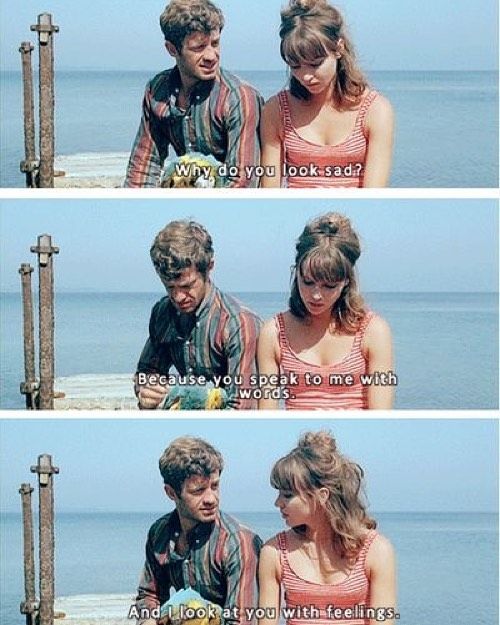Strategy, is it you?

Ferdinand: Why do you look so sad?
Marianne: Because you speak to me in words and I look at you with feelings.

Work these days = all the feels.
This scene from a French movie from 1965 could be a scene happening any day at any office. We all work in an environment where emotional intelligence becomes the dominant skill (of leadership). Long gone are the days, where you could calculate, command and control actions needed to take to get to a brighter future. Instead (especially after Corona) I see everyone showing up as human beings with all their baggage, complex personalities & feelings and with their desire to personally contribute along their strengths. It’s humans in full force. They only move when they are inspired to move and they only fully contribute if they have a personal invest in what they do. Our tools, our methods and our way of working, however, doesn't keep up. To me, it's clear, that as our understanding about work itself changes, so needs our understanding of strategy.
Funnily though, strategy work often still ignores this complexity and context. It is still seen as one of the rare domains of rationality - the fortress of sound argumentations. As rigidly making a plan, following a straight line from A to B. Oftentimes, this straight line is backed by elaborate argumentations and excel sheets making sure that everyone understands that there is nothing but this one path that will get to us to the goal. Strategy aims at being factual and correct. However, this is not how reality works. Life is what happens while you’re busy making other plans. So, usually what happens is one of three things:
Scenario 1: Strategy as a self-interest
Very elaborate presentations and excel sheets that took forever to make, but never see the light of day again and will dust until the end of time in the drawers of c-level.
Effect: Strategy becomes the thing that makes everything more complicated that it needs to be
→ Waste of time.
Scenario 2: Strategy as regulatory.
Strategy or guidelines that are communicated like laws that need to be dutifully abided by all people, give orientation but rob them of the opportunity to sense, think and react to changing environments.
Effect: Strategy becomes the party pooper: people who squeeze reality into tiny squared boxes and ignore that their plans crash with real life as soon as it hits
→ Waste of time
Scenario 3: Strategy as island of paradise
Big ideas and visions detached from real life, oftentimes just copy and pasted from the most successful competitors and totally separate from the daily tasks and actions of the people that work with you.
Effect: Strategy becomes the ivory tower of illusion. In good cases, it's just being ridiculed, in bad cases it leads to growing cynicism.
→ Waste of time.
It shouldn’t come as a surprise, that these types of strategy don’t work and I’ve seen them fail over and over again. I don’t know about you but I don't want my strategies to be some taxidermy, some thing that is dead before it ever saw the light of day. So with every failed strategy I’ve tried to reflect on what it would need instead: a vehicle that lets you make better decisions, get down to action and (most importantly) inspire other to move with you in joint spirits. What we need is a better mental model for strategy: one that is made for humans, one that inspires for collective action and that allows us to make better decision even in times of uncertain outcomes.
Strategy is creating a pact for the future.
Thus for me, working strategically should be about creating a pact for the future. By following the strategy we make a promise to each other that all of our future decisions will be in line with that pact and that we can hold each other accountable to that. Because something better than today is the reward for collective action.
I like this mental model because it creates the right associations in my mind:
A promise is something voluntary, it’s nothing that you can dictate people to do (that is called blackmailing), but that you need to inspire people to buy into. So it needs to consider everyone’s motivations and needs to be rooted in a relationship of trust. It’s something very strong that people can count on, so it creates accountability and responsibility. But a promise is also flexible in its manifestations. It doesn’t need a rulebook to spelled out in order to understand its boundaries. You can keep your promise also in changing environments because you know what it is about in its core.
And this is exactly what I want my strategies to be.
The basis for Trust & Transparency
If done right, strategic work is the basis for trust in leadership. First of all, because it requires you as the leading person to have spent some thoughts on the future of your context and to have developed some sort of attitude and approach for it. That the decision you make are made consciously, respecting the consequences and implications that arise from them. In contrast to running around oblivious to what will happen and base your decision on randomness and personal whims. Having a strategic promise in place, not only creates trust in your actions but also gives transparency on what you as a leader intend to do in the upcoming months and years and gives people the chance to contribute.
Empowerment & Accountability
If you get the promise right, people feel not limited or regulated, but empowered and invested in driving the strategy together with you. Make your strategic choices explicit and transparent and and invite for regular strategic discussions that include everyone. That way you can not only hold each other accountable on the pact, but also generate much more speed and force in driving your work forward. And by doing so, you allow everyone to see how they can create impact themselves. In my experience there's nothing more motivating and empowering than knowing how your individual action contributes to the bigger picture.
Autonomy & Alignment
The sum of decisions made in a company shows how strategic you really are and as a leader you can’t make all of them or control the people who do. Your job is to make the underlying pact so crystal clear, that everyone in the organisation would make a decision similar to the one you would make or at least one that ressembles the underlying values and ambitions. By that, you give people the autonomy to act (instead of waiting) and create alignment in the outcomes at the same time.
When time is the investment, the return on invest is meaning and my job is to maximize the meaning of all those people who have a connection to my company
I’m aware that this kind of vocabulary doesn’t sound like usual strategy talk at all (goals, objectives, tradeoffs etc.). It elicits totally different images in your head and that’s exactly the point. As I see the world today, every person in the industry that I’m working in, can decide what amount of their time they want to invest in their business life and where and how they want to invest it. The only thing I - as their leader - can do is come up with a good enough vision of how I can help them translate their time into positive outcomes and meaning. (To use economic vocabulary: When time is the investment, the return on invest is meaning and my job is to maximize the meaning of all those people who have a connection to my team/company). A strategy - as in a promise or pact for a meaningful future - that is inspiring, allows them to have a personal invest and creates accountability for action is the best I can do.

Key Takeaways
- What's a pact that you want to make with your team or your company?
- How can you create more space for strategic discourse in your team?
- What's the meaning of your work?
- A fabulous book on leadership traits for the emtional intelligent office: https://www.theschooloflife.com/shop/tsol-press-the-emotionally-intelligent-office/
- The new Skills for 2030: https://www.oecd.org/education/2030-project/teaching-and-learning/learning/skills/Skills_for_2030_concept_note.pdf
